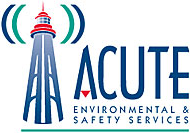
You must take confined space entry training if your job requires suiting up and climbing into potentially hazardous areas that aren’t built for human occupancy. In Part 2 of our Fundamental Guide to Confined Space Entry Training, you will learn exactly who needs to this course. You should also read Part 1 on relevant rules and regulations. When it’s time for you to register for confined space entry training, you should trust the experienced professionals at Acute Safety and Safety Services to get you trained and keep you safe on the job – contact us or sign up for our confined space entry training today.
![]()
Confined Space Entry Training – Fundamental Guide: Part 2
In Part 1 of this series, you learned about the relevant rules and regulations surrounding confined spaces, and here in Part 2, you will discover who exactly needs to take the confined space entry training course.
Do You Need Confined Space Training?
According to the Ontario Ministry of Labour, Immigration, Training and Skills Development, “every worker who works in a confined space must receive adequate training in the recognition of hazards associated with confined spaces and training to be able to safely perform the assigned duties for that specific confined space.” Additionally, training is required if you will be contributing to the work activity – attendants and rescue workers, for example.
ACUTE offers both a Confined Space Entry Awareness and a Confined Space Rescue course.
It’s important to note that simply receiving instructions as a confined space worker does not ensure that you are competent to safely perform the task; hands-on training should be an essential part of your confined space training. In cases where a worker is new to the job and does not have sufficient experience, it’s good practice to make sure they’re teamed up with more experienced workers on top of receiving the necessary training.
In Part 3 of this series, you will read about what you are expected to learn from a confined space entry training course. In addition, make sure you check out our article “Confined Spaces Training: 3 Things You Need To Know.”

Before going to work in a confined space, you need the right training.
Are You a “Competent Person”?
Once you have completed the confined space entry training, you will have adequate knowledge, training, and experience to work in this area. Don’t forget – a refresher course will need to be taken every three years. Additionally, and according to the Ontario Ministry of Labour, Immigration, Training and Skills Development, a competent person is above and beyond a person having adequate knowledge, training, and experience. There is an added responsibility of also having “to organize the work”, which usually is associated with a supervisor’s responsibility.
The term “competent person” is defined in the Occupational Health and Safety as follows:
- “competent person” means a person who,
- is qualified because of knowledge, training and experience to organize the work and its performance;
- is familiar with this Act and the regulations that apply to the work, and
- has knowledge of any potential or actual danger to health or safety in the workplace.
While as a supervisor you may have had a role in organizing the work, you may not necessarily be able to carry out the specific task or tasks. And if you do have the training to work in confined spaces, you may not be involved in all of the behind-the-scenes details.
What Does a Competent Person Do?
A competent person, therefore, is responsible for developing and implementing the confined space plan, and the verification that the entry permit continues to comply with the plan, prior to the start of each shift (and before initial entry). As a competent person, you will also be required to:
- Carry out an adequate assessment of the hazards in the confined space before any worker enters the confined space
- Sign and date the assessment and provide it to the employer
- Conduct the general training of workers before they are allowed to enter the confined space
- Inspect the rescue equipment to ensure it is in good working order
- Perform adequate tests as often as necessary to ensure that acceptable atmospheric levels are maintained in the confined space, in accordance with the relevant plan
- Inspect the personal protective equipment used by workers entering the confined space where there are atmospheric hazards.
In order to be considered a competent person, you must also take a course like ACUTE’s Confined Space Rescue Training course.

A competent person is required to go above and beyond the regular training in order to implement and carry out the confined space work plan.
Trust ACUTE for Confined Space Entry Training
Hands-on, practical confined space entry training is the best way to keep employers and workers safe in the workplace!
ACUTE is dedicated to workplace safety and understands the importance of course and training provider approval. ACUTE offers many training courses to help workers, employers, and everyone else involved stay safe on the job.
You can trust ACUTE to help your business understand your training challenges while also taking care of the most crucial aspect of a safety program: providing unparalleled tailoring and customer service. Contact us today.
“Acute Environmental Safety is a premier Ontario based company that we use for its professionalism, reliability and flexibility. We know we can count on Acute to deliver the most up to date regulatory information to help us manage our business in the field. Their unique operational expertise in addition to their strong regulatory knowledge helps them to deliver their programs in a way that our workers understand and appreciate. Acute is always there when we need them and will customize their delivery as required.” – Todd, Environmental Clean Up Company
ACUTE is located in Waterloo, Ontario, and services customers from cities such as Toronto, Mississauga, Brampton, Hamilton, Milton, Kitchener, London, Guelph, and others across Ontario.

